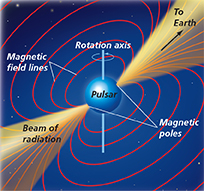As a supernova spews material into space, its core continues to collapse. If the remaining core has a mass less than about three times the sun's mass, it will become a neutron star. A neutron star is the dense remnant of a high-mass star that has exploded as a supernova. In a neutron star, electrons and protons are crushed together by the star's enormous gravity to form neutrons. Neutron stars are much smaller and denser than white dwarfs. A spoonful of a neutron star would weigh nearly a billion tons on Earth! A neutron star with the mass of the sun would be only about 25 kilometers across, the size of a large city.
Figure 19 Pulsars emit steady beams of radiation that appear to pulse when the spinning beam sweeps across Earth.

Like a spinning ice skater pulling in his arms, a neutron star spins more and more rapidly as it contracts. Some neutron stars spin hundreds of turns per second! As shown in Figure 19, neutron stars emit steady beams of radiation in narrow cones. If the neutron star is spinning, these emissions appear to pulse on and off at regular intervals, like the spinning beacon on a lighthouse. Each time one of these beams of radiation sweeps across Earth, astronomers can detect a pulse of radio waves. A spinning neutron star that appears to gives off strong pulses of radio waves is called a pulsar.
As impressive as pulsars are, very massive stars can have even more dramatic ends. If a star's core after a supernova explosion is more than about three times the sun's mass, its gravitational pull is very strong. Gravity causes the core to collapse beyond the neutron-star stage. As the collapse continues, the pull of gravity increases and the speed required to escape the star's core reaches the speed of light. Beyond this point, nothing can escape and a black hole is formed. A black hole is an object whose surface gravity is so great that even electromagnetic waves, traveling at the speed of light, cannot escape from it.
Section 26.3 Assessment
Reviewing Concepts
 How does a star form?
How does a star form? What factor determines the length of a star's life?
What factor determines the length of a star's life? Why do some stars become white dwarfs while others become neutron stars or black holes?
Why do some stars become white dwarfs while others become neutron stars or black holes?
Critical Thinking
Predicting A main-sequence star has a mass 5 times that of the sun. What will be its final stages?
Comparing and Contrasting How are a protostar and a star different?
Comparing and Contrasting Why do lowmass stars remain on the main sequence longer than high-mass stars?
Writing in Science
Explain a Sequence Write a paragraph explaining the sequence of events that resulted in the creation of the elements that make up your body.




